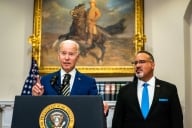You have /5 articles left.
Sign up for a free account or log in.
I have been a college president for over a decade now. During my career I’ve not shied away from using the bully pulpit to address a number of issues. This includes questioning obscene gifts wealthy individuals have given to obscenely wealthy universities that primarily serve an obscenely wealthy student body.
If you don’t believe me, ask Dr. Dre, whom I took to task when he donated (along with Jimmy Iovine) $70 million to the University of Southern California. In 2007, I wrestled with the celebration of John Kluge, who gave Columbia $400 million, at the time the fourth-largest single gift ever to a university. I argued that this gift was simply the perpetuation of privilege.
Eight years later, Harvard University is in the news as alumnus John Paulson donated $400 million, the largest single gift to the oldest university in the United States and richest university on the planet.
But something is different today. A chorus of people from diverse backgrounds publicly expressed consternation about this gift. Some argued that gifts to the wealthy are not charity. Some lamented that the taxpayers pay for the tax breaks for the wealthy. Others still, notably Malcolm Gladwell, highlighted pressing issues we see across the globe and questioned how anyone could make this kind of gift today.
This is good. Diverse voices are now beginning to think critically about issues of equality and wealth. Whenever I’ve raised the issues, predictable criticisms come in. They tell me I’m just a hater because my institution is a poor performer (as they compare underresourced colleges against overly resourced ones as if they are equal).
This is just like saying Slovenia performed poorly in the 2014 Winter Olympics since the U.S. won 28 medals to its 8. Yet in medals per capita they were 4th (we were 21st), and in medals per GDP they were 2nd (we were 23rd). Slovenia did more with less (just like historically black colleges).
Others ask their favorite version of the “why do we need black colleges” question in this era of resegregated K-12 schools and overwhelmingly segregated neighborhoods, where all of our taxes support public, historically black elementary, middle and high schools. And yet these same folks were silent when black Harvard students through the I Too Am Harvard campaign complained about the racism they experience daily.
Hedge fund managers defended Paulson, arguing that giving resources to the brightest Americans will have a multiplier effect for the nation. The recent survey of the Harvard graduating class of 2015 indicated that a third of them are going into their top two career choices: finance and consulting. If multiplier means personal wealth, that defense of the gift is correct.
Some praised the gift because it will support research and innovation that can benefit humanity. Of course this is true, but if we don’t address key issues like K-12 education and job prospects for all, only the wealthy will benefit from these great advances.
Other argued that the gift would also be for scholarships and financial aid. In fact, when the pushback began both Paulson and Harvard reiterated this point, noting that low-income students could attend for free. It is on this point where I realize that we have much more work to do.
Here are the facts. Harvard’s total cost annually is $62,000. Yes, that’s just the sticker price, but when more than 40 percent of your student body receives no aid at all, we’re not talking about a needy population. Just 17 percent of the student body receives Pell Grants. At my institution, Dillard University, 98 percent of my students receive some form of aid, including 80 percent receiving the Pell Grant.
The Harvard Crimson reported that in the recent freshman class, the average student comes from a family with between $125,000 and $250,000 in annual income, and 14 percent have household income above $500,000, placing them among the wealthiest in America. The median family income in New Orleans, where I work, is $35,000, and for my students is $31,000. The writers for The Crimson said it best in describing the class of 2017: “In Harvard Yard, 14 percent are the 1 percent.”
This gift increases Harvard’s endowment by a little over 1 percent. For me? It would increase it by over 500 percent. In fact, with a $400 million gift, I could use a 5 percent spending rate and pay the tuition and fees for all 1,200 Dillard students -- with money left over.
And that’s where we have to mature as a nation. Mega-gifts to the mega-rich can best be described as trendy. Everyone likes a winner and to be associated with a great brand. Harvard is so good they don’t need a tagline or branding campaign. If they did I imagine Dave Chappelle yelling, “Harvard. We’re rich, (rhyming bad word)!”
In fact, the key defense for these trendy gifts is always, “It’s his money.” I agree 100 percent. Paulson and Harvard only need to say that Harvard is his university, nurtured him, and he is blessed to do whatever he can for something he loves like family. They could simply drop the mic and move on.
This is in fact the best, most succinct and sincere answer they can and should give. Anything else is crap.
But when do the Paulsons of the nation transform the lives of people they may never meet? I tell donors when they support a Dillard student, they aren’t just supporting that student or changing their trajectory -- they have transformed generations of a family. It means a student on full scholarship doesn’t have to work two or three jobs to continue to support the family back home. It means a student can accept an unpaid Washington internship rather than cobble together summer jobs to pay tuition that is a fraction of Harvard’s.
The discussion around this new gift is encouraging. A new level of consciousness is growing. Hopefully we’ll have a new level of courage among ultrawealthy individuals, a level that allows them to share their resources with those who might not look like them or share their background or experiences.
People who, with the right investment, produce a generational multiplier effect that a gift to Harvard could never produce. This requires a transformational love, a love for those we do not know and will never meet.








